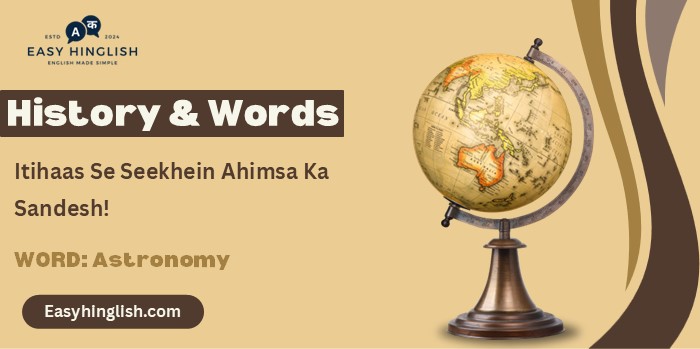History & Words: ‘Astronomy’ (January 23)
Welcome to ‘History & Words.’ 🌟 Main Prashant hoon, Wordpandit aur Learning Inc. Network ka sansthapak. Yeh series meri bhasha seekhne ki lagan aur itihas ke prati ruchi ka sangam hai. Har kadi ek shabd aur uss se judi ek tithi par roshni daalti hai, jisse aapka shabdkosh badhta hai aur aap itihas ko gehraai se samajh paate hain. Aaiye, iss safar mein shabdon ke madhyam se samay mein pichhe chalein.
🔍 Word of the Day / Aaj ka Shabd: Astronomy
Uchcharan: /əˈstrɒn.ə.mi/ (uh-STRON-uh-mee)
🌍 Parichay (Introduction)
23 January 1978 ko Sweden duniya ka pehla desh bana jiske ne aerosol sprays par ban lagaya. Yeh decision sirf environment se related nahi tha – iska base tha astronomical observations, jinhone ozone layer ke depletion ko proof kiya.
Is event ne yeh dikhaya ki astronomy sirf taare dekhne ka science nahi, balki prithvi ki suraksha ka ek practical tool bhi ban sakti hai. Jab space-based techniques ne dharti ke atmosphere ka study start kiya, tab se astronomy ek environmental science ka bhi hissa ban gaya.
🌱 Shabd ka Utpatti (Etymology)
“Astronomy” shabd aaya hai Greek se:
- “Astron” = star
- “Nomos” = law
Iska matlab hua “law of the stars” – yaani taare aur celestial bodies ke niyam aur principles ko samajhna.
📖 Mahatvapurn Shabdavali (Key Vocabulary)
- 🔑 Ozone Layer: Atmosphere ka wo hissa jo UV radiation se humein bachata hai
- 🔑 Spectroscopy: Light aur matter ke interaction ka adhyayan
- 🔑 CFCs (Chlorofluorocarbons): Aerosol sprays mein use hone wale chemicals jo ozone ko damage karte hain
- 🔑 Stratosphere: Atmosphere ka layer jahan ozone layer hoti hai (10–50 km upar)
🏛️ Itihasik Sandarbh (Historical Context)
Pehle astronomy ka use hota tha navigation, calendar aur religious rituals ke liye. Lekin modern telescopes aur spectroscopy ke development ke baad yeh science precise aur practical ho gayi.
1970s mein scientists ne space-based aur atmospheric instruments ke through CFCs ka presence aur unka ozone layer pe impact observe kiya. Yeh discovery astronomy aur environmental science ke beech ki pehli major collaboration thi.
Sweden ka 1978 ka ban ek scientific evidence pe based public policy ka example bana.
⏳ Samayrekha (Timeline)
- 1930s: CFCs ka consumer use start hota hai
- 1974: Ozone depletion aur CFCs link dikhane wali research publish hoti hai
- 1977: Ozone layer par pehli detailed astronomical studies
- 23 Jan 1978: Sweden bans aerosol sprays
- 1985: Antarctic ozone hole discover hota hai
- 1987: Montreal Protocol sign hota hai
- 2019: Satellite observations ozone recovery confirm karte hain
🌟 Is Din ka Mahatva (The Day’s Significance)
23 January 1978 ne dikhaya ki celestial science ka practical use Earth pe bhi ho sakta hai. Sweden ka decision ek warning aur wake-up call tha duniya ke liye.
Is moment ne yeh prove kiya ki space science se mile data se policy decisions liye ja sakte hain – aur iske baad ozone aur climate research ke liye astronomical technology ka zyada use hone laga.
💬 Prasiddh Ukti (Quote)
“The Earth is a very small stage in a vast cosmic arena… To preserve and cherish the pale blue dot, the only home we’ve ever known.”
— Carl Sagan
🔮 Aaj Ka Matlab aur Chintan (Modern Usage and Reflection)
Aaj astronomy ka role expand ho chuka hai – sirf galaxies nahi, Earth ke atmosphere, climate aur pollution tak. Satellites, space probes aur telescopes se milta data environmental monitoring ke liye essential ho gaya hai.
Is field ka integration environmental science se ho chuka hai – jisse naye careers aur subfields develop ho rahe hain.
🏛️ Virast (Legacy)
Sweden ke ban ne ek example set kiya – ki scientific data (chahe wo space se ho) policy making mein use ho sakta hai.
Montreal Protocol jese agreements is spirit ko continue karte hain – aur aaj ozone layer recovery ka proof bhi satellite-based astronomy ne hi diya hai.
🔍 Tulnatmak Vishleshan (Comparative Analysis)
Pehle astronomy ek theoretical aur distant science thi – sirf stars aur planets ke study tak limited. 1978 ke baad yeh practical aur earth-relevant science ban gayi.
Is transition ne bataya ki science kabhi kisi boundary mein limited nahi hoti.
💡 Kya Aapko Pata Hai? (Did You Know?)
🎓 Antim Vichar (Conclusion)
23 January 1978 ka din ek reminder hai ki humari sabse purani science – astronomy – aaj bhi sabse relevant hai. Jab space science dharti ke problems ko solve karne lage, to humein yaad aata hai – stars sirf door nahi, andar bhi roshni laate hain.
📚 Aage Padhne Ke Liye (Further Reading)
- 📘 Protecting the Ozone Layer – Edward A. Parson
- 📗 Atmospheric Science at NASA – Erik M. Conway
- 📙 The Planet Observers’ Handbook – Fred W. Price








